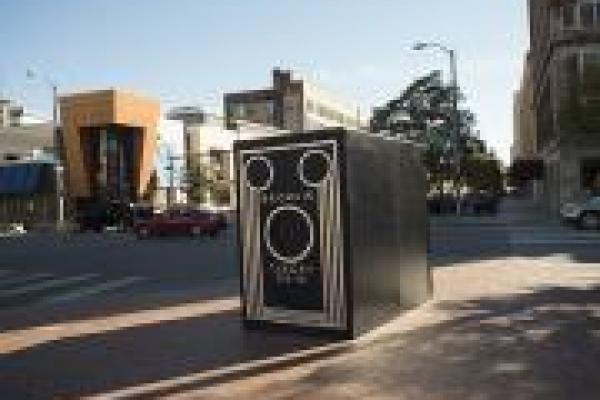STEAM Factory member Stephen Takacs to hit Society of Photographic Education National Conference with camera obscura, Target Six-16

Have you ever wondered what led to the invention of photography? Or perhaps the first camera?
Stephen Takacs has created Target Six-16, a human-sized, interactive camera obscura installation to give the public an inside look at one of the world's oldest photographic devices. Takacs, an Ohio State University lecturer and local artist, has now taken his creation on the road traveling the nation - sharing his project with the Ingenuity Fest in Cleveland, The Columbus Mini Maker Faire, and The Midwest Society of Photographic Education Regional Conference in Lincoln, Nebraska.
The next stop for Target Six-16 will be the Society of Photographic Education National Conference in Baltimore, Maryland March 6-9.
A camera obscura is a box or room with a hole in one side that projects an image of its surroundings on a screen. Light from an external scene passes through the hole and strikes a surface inside, where it is reproduced, and turned upside down to show us what our eyes see before our brains correct an image.
With the help of the Columbus Idea Foundry's assistant director, Casey McCarthy, and Brittany Lawson, a local artist and small business owner with a studio at 400 West Rich Studios, the three were able to collaborate, split up tasks, and create Target Six-16. The camera stands at 5' x 8' x 7.5' and viewers can enter it and experience a real time view of the world turned upside down through the lens of a camera.
Part of Takacs' interest with sharing his project is the opportunity to give back.
"I hope to create experiences that are engaging, educational, and inspiring," Takacs said.
On the front of the camera there is a lens and a small infrared motion senor that is connected to the camera shutter. When movement activates the sensor, an electric motor opens the shutter allowing light to enter the camera via the lens. The camera's lens projects an upside-down image of the exterior world onto a semitransparent fabric screen found on the interior of the camera obscura. Viewers can physically move and manipulate the screen to alter the focus of the image or simply enjoy the view of the world turned upside down.
Designed from a full-sized prototype,Target Six-16 was constructed with portability in mind. It is comprised of aluminum pipe, kee klamps, and a water-resistant skin. Designed like a tent, the camera can flat pack to a small size that can fit into a car.
In addition to being an immersive sculptural art installation,Target Six-16 is also a functional camera, capable of developing photographs. The first images were made using large 16" x 20" pieces of ortho film that had to be contact printed to make a positive image. Recently, Takacs has begun making even larger images using a special paper that yields a direct positive black and white image after chemical development. Takacs' next step is fine-tuning a system to develop the images on-site using the camera itself as a darkroom for developing the images. The ultimate goal is to be able to produce 50" wide final prints out in the field.
Besides being an educational experience for viewers, Takacs is using Target Six-16 to create a new body of artwork.
"Traveling with the camera allows me to create new work," Takacs said. "Every time I set up the camera obscura, I make a photograph with it and of it. The images serve as documents of an evolving performance."
You can catch Takacs and his Target Six-16 camera obscura on display next at Nationwide Children's Hospital's Starry Night on April 6th at Westerville South High School or at an upcoming event at 400 West Rich this spring.
A member of the STEAM Factory; Takacs' Target Six-16 was funded in part by its Outreach and Engagement Impact Grant.
